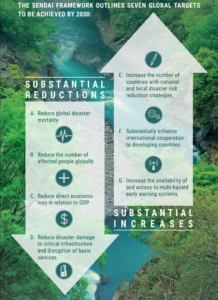In news : Recently, in virtual address, the Prime Minister of India emphasised that 2021 being the mid-point of the Sustainable Development Goals (SDG), the Paris agreement and the Sendai Framework, the expectations from the COP26 later this year are highThe COP-26 is the 26th UN conference on climate change being organised by the UK in Glasgow from November 1-12
The Sendai Framework for Disaster Risk Reduction 2015-2030 (Sendai Framework)
- It was the first major agreement of the post-2015 development agenda and provides Member States with concrete actions to protect development gains from the risk of disaster.
- Goal: Prevent new and reduce existing disaster risk through the implementation of integrated and inclusive economic, structural, legal, social, health, cultural, educational, environmental, technological, political and institutional measures that prevent and reduce hazard exposure and vulnerability to disaster, increase preparedness for response and recovery, and thus strengthen resilience
- Scope & Purpose:
- The present framework will apply to the risk of small-scale and large-scale, frequent and infrequent, sudden and slow-onset disasters, caused by natural or manmade hazards as well as related environmental, technological and biological hazards and risks.
- It aims to guide the multi-hazard management of disaster risk in development at all levels as well as within and across all sectors
- The Framework works hand in hand with the other 2030 Agenda agreements, including The Paris Agreement on Climate Change, The Addis Ababa Action Agenda on Financing for Development, the New Urban Agenda, and ultimately the Sustainable Development Goals.
- It was endorsed by the UN General Assembly following the 2015 Third UN World Conference on Disaster Risk Reduction (WCDRR)
- It recognizes that the State has the primary role to reduce disaster risk but that responsibility should be shared with other stakeholders including local government, the private sector and other stakeholders.

Four priority areas of the framework
- Understanding disaster risk
- Strengthening disaster risk governance to manage disaster risk
- Investing in disaster reduction for resilience and
- Enhancing disaster preparedness for effective response, and to “Build Back Better” in recovery, rehabilitation and reconstruction.
Targets under the Framework
- Substantially reduce global disaster mortality by 2030, aiming to lower average per 100,000 global mortality between 2020-2030 compared to 2005-2015
- Substantially reduce the number of affected people globally by 2030, aiming to lower the average global figure per 100,000 between 2020-2030 compared to 2005-2015
- Reduce direct disaster economic loss in relation to global gross domestic product (GDP) by 2030
- Substantially reduce disaster damage to critical infrastructure and disruption of basic services, among them health and educational facilities, including through developing their resilience by 2030
- Substantially increase the number of countries with national and local disaster risk reduction strategies by 2020
- Substantially enhance international cooperation to developing countries through adequate and sustainable support to complement their national actions for implementation of this framework by 2030
- Substantially increase the availability of and access to multi-hazard early warning systems and disaster risk information and assessments to people by 2030
















